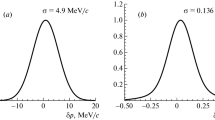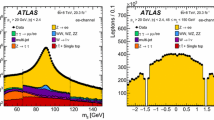Abstract
Ultraperipheral heavy-ion collisions provide a unique opportunity to study two-photon-induced processes. Production of tau-lepton pairs in the process \({\text{Pb}} + {\text{Pb}} \to {\text{Pb}} + {\text{Pb}} + \tau \tau \) at the LHC is of particular interest, since its cross section is sensitive to poorly known electromagnetic moments of the \(\tau \) lepton. Possible deviations of the anomalous magnetic moment \({{a}_{\tau }} = {{(g - 2)} \mathord{\left/ {\vphantom {{(g - 2)} 2}} \right. \kern-0em} 2}\) of the \(\tau \) lepton from the Standard Model predictions may indicate the presence of effects beyond the Standard Model, such as contributions of supersymmetric particles to the lepton production or the composite nature of the \(\tau \) lepton. The prospects for measurements of the exclusive cross section of \(\tau \) lepton production in ultraperipheral Pb–Pb collisions at the LHC are discussed, and esimations of possible \({{a}_{\tau }}\) limits are presented.




Similar content being viewed by others
REFERENCES
A. J. Baltz et al., “The physics of ultraperipheral collisions at the LHC,” Phys. Rep. 458, 1-171 (2008).
J. G. Contreras and J. D. Takaki Tapia, “Ultra-peripheral heavy-ion collisions at the LHC,” Int. J. Mod. Phys. A 30 1542012 (2015).
M. Aaboud et al. (ATLAS Collab.), “Evidence for light-by-light scattering in heavy-ion collisions with the ATLAS detector at the LHC,” Nat. Phys. 13, 852–858 (2017).
A. Sirunyan et al. (CMS Collab.), “Evidence for light-by-light scattering and searches for axion-like particles in ultraperipheral PbPb collisions at \(\sqrt {{{s}_{{NN}}}} \) = 5.02 TeV,” Phys. Lett. 797, 134826 (2019).
J. Adams et al. (STAR Collab.), “Production of e + e – pairs accompanied by nuclear dissociation in ultraperipheral heavy-ion collisions,” Phys. Rev. C 70, 031902 (2004).
S. Afanasiev et al. (PHENIX Collab.), “Photoproduction of J/ψ and of high mass e + e – in ultra-peripheral Au + Au collisions at \(\sqrt {{{s}_{{NN}}}} \) = 200 GeV,” Phys. Lett. B 679, 321–329 (2009).
E. Abbas et al. (ALICE Collab.), “Charmonium and e + e – pair photoproduction at mid-rapidity in ultra-peripheral Pb–Pb collisions at \(\sqrt {{{s}_{{NN}}}} \) = 2.76 TeV,” Eur. Phys. J. C 73, 2617 (2013).
G. Aad et al. (ATLAS Collab.), “Exclusive dimuon production in ultraperipheral Pb + Pb collisions at \(\sqrt {{{s}_{{NN}}}} \) = 5.02 TeV with ATLAS,” Phys. Rev. C 104, 024906 (2021).
L. Beresford and J. Liu, “New physics and tau g–2 using LHC heavy ion collisions,” Phys. Rev. D 102, 113008 (2020).
M. Dyndał, M. Kłusek-Gawenda, A. Szczurek, and M. Schott, “Anomalous electromagnetic moments of τ lepton in γγ → τ+τ– reaction in Pb + Pb collisions at the LHC,” Phys. Lett. 809, 135682 (2020).
B. Odom, D. Hanneke, B. D’Urso, and G. Gabrielse, “New measurement of the electron magnetic moment using a one-electron quantum cyclotron,” Phys. Rev. Lett. 97, 030801 (2006).
D. Hanneke, S. Fogwell Hoogerheide, and G. Gabrielse, “Cavity control of a single-electron quantum cyclotron: Measuring the electron magnetic moment,” Phys. Rev. A 83, 052122 (2011).
B. Abi et al. (Muon g–2 Collab.), “Measurement of the positive muon anomalous magnetic moment to 0.46 ppm,” Phys. Rev. Lett. 126, 141801 (2021).
D. J. Silverman and G. L. Shaw, “Limits on the composite structure of the τ lepton and quarks from anomalous-magnetic-moment measurements in e + e – annihilation,” Phys. Rev. D 27, 1196 (1983).
S. P. Martin and J. D. Wells, “Muon anomalous magnetic dipole moment in supersymmetric theories,” Phys. Rev. D 64, 035003 (2001).
G. W. Bennett et al. (Muon g-2 Collab.), “Final report of the E821 muon anomalous magnetic moment measurement at BNL,” Phys. Rev. D 73, 072003 (2006).
F. del Aguila, F. Cornet, and J. Illana, “The possibility of using a large heavy-ion collider for measuring the electromagnetic properties of the tau lepton,” Phys. Lett. 271, 256–260 (1991).
J. Abdallah et al. (DELPHI Collab.), “Study of tau-pair production in photon-photon collisions at LEP and limits on the anomalous electromagnetic moments of the tau lepton,” Eur. Phys. J. C 35, 159 (2004).
G. Aad et al. (ATLAS Collab.), “The ATLAS experiment at the CERN Large Hadron Collider,” J. Instrum. 3, S008003 (2008).
S. Chatrchyan et al. (CMS Collab.), “The CMS Experiment at the CERN LHC,” J. Instrum. 3, S08004 (2008).
K. Aamodt et al. (ALICE Collab.), “The ALICE Experiment at the CERN LHC,” J. Instrum. 3, S08002 (2008).
M. Kłusek-Gawenda, P. Lebiedowicz, O. Nachtmann, and A. Szczurek, “From the γγ → \(p\bar {p}\) reaction to the production of \(p\bar {p}\) pairs in ultraperipheral ultrarelativistic heavy-ion collisions at the LHC,” Phys. Rev. D 96, 094029 (2017).
T. Sjöstrand, “The PYTHIA event generator: Past, present and future,” Comput. Phys. Commun. 246, 106910 (2020).
R. Escribano and E. Massó, “New bounds on the magnetic and electric moments of the tau lepton,” Phys. Lett. 301, 419 (1993).
K. Hencken, E. A. Kuraev, and V. G. Serbo, “Exclusive and inclusive muon pair production in collisions of relativistic nuclei,” Phys. Rev. C 75, 034903 (2007).
S. Klein, A. H. Mueller, B. W. Xiao, and F. Yuan, “Lepton pair production through two photon process in heavy ion collisions,” Phys. Rev. D 102, 094013 (2020).
Funding
The work was supported by the Russian Foundation for Basic Research, project no. 21-52-14006, and the Austrian Science Fund, project no. I 5277-N.
Author information
Authors and Affiliations
Corresponding author
Additional information
Translated by M. Potapov
Rights and permissions
About this article
Cite this article
Burmasov, N., Kryshen, E., Bühler, P. et al. Feasibility Studies of Tau-Lepton Anomalous Magnetic Moment Measurements in Ultraperipheral Collisions at the LHC. Phys. Part. Nuclei 54, 590–594 (2023). https://doi.org/10.1134/S1063779623040111
Received:
Revised:
Accepted:
Published:
Issue Date:
DOI: https://doi.org/10.1134/S1063779623040111




